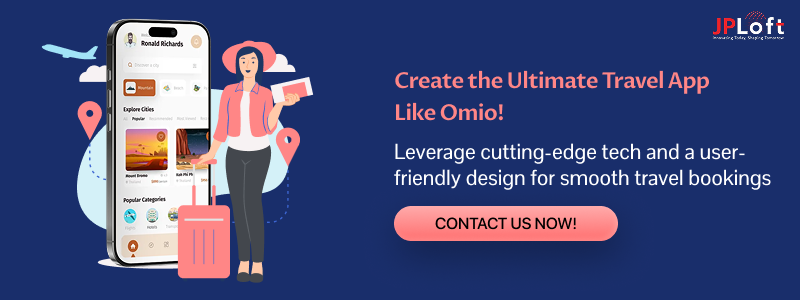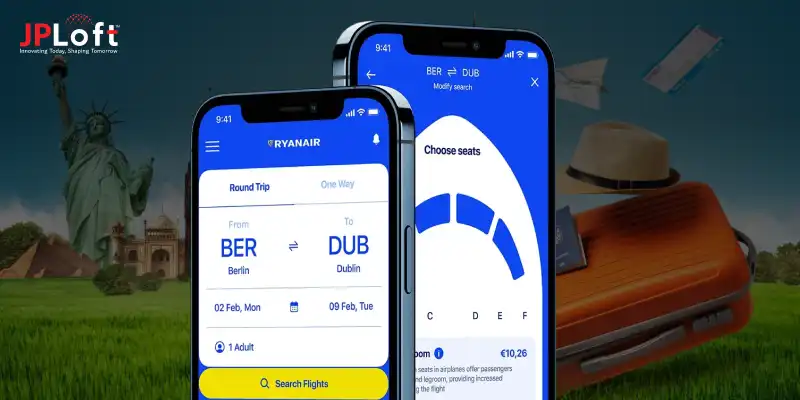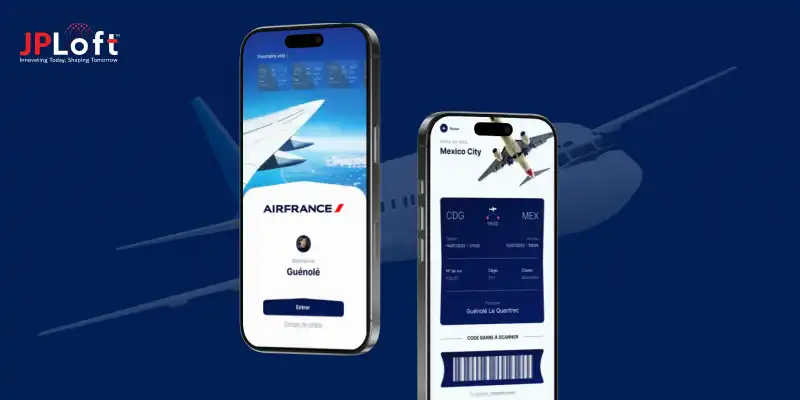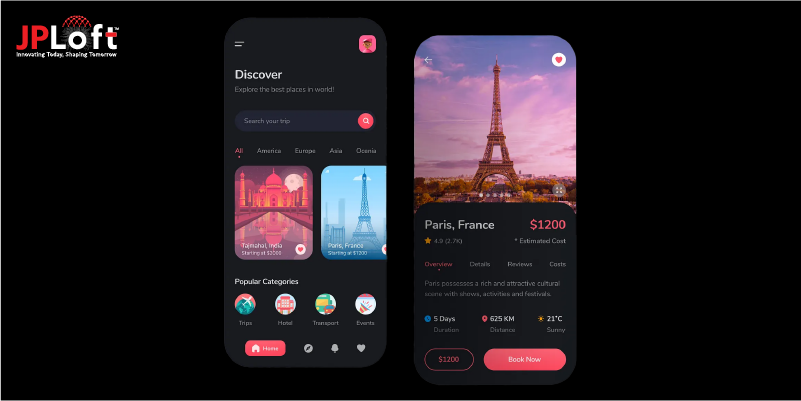Planning trips across Europe can get overwhelming—multiple operators, currencies, languages, and booking platforms. That’s where Omio stepped in and changed the game.
By allowing users to compare and book trains, buses, and flights in one app, it simplified travel for millions.
If you're exploring how to create an app like Omio, you're entering a space full of potential.
With travel demand bouncing back and digital-first experiences becoming the norm, now is a smart time to make an app like Omio.
In this blog, we’ll walk you through everything—from features and development steps to costs and AI trends—to help you understand how to build an app like Omio that performs at scale and delivers seamless travel experiences.
Key Takeaways
Omio’s success proves the growing demand for unified travel booking across Europe’s complex transport landscape.
Building an Omio-like app offers high growth potential due to low competition and strong mobile adoption.
To develop an app like Omio, focus on seamless APIs, user-centric design, and multi-modal travel integrations.
The cost of Omio-like app development ranges from $35,000 to $120,000+, depending on features and AI/ML modules.
Challenges like real-time data aggregation, localization, and compliance must be planned for from day one.
AI, ML, NLP, AR, and voice-enabled features are transforming how users engage with travel apps.
Now is the right time to create a travel app like Omio, and partnering with JPLoft can fast-track success.
What Is Omio and How Does It Work?
Omio is a popular European travel app that allows users to search, compare, and book trains, buses, and flights across multiple providers—all in one interface.
Originally launched in Germany, the platform now operates in 37 countries and supports 21 languages.
It works by aggregating real-time transport data from various operators, helping users find the fastest, cheapest, or most convenient routes based on their preferences.
With transparent pricing and a mobile-first design, Omio simplifies complex travel planning into just a few taps.
If you’re looking to build an app like Omio, it’s important to focus on seamless API integrations, user-friendly design, and localized travel experiences.
Omio’s Market Stats: How Big Is the Opportunity?
Before you build an app like Omio, it's important to understand the scale and traction the platform has achieved.
The following stats highlight just how big the opportunity is in the European travel tech space.
A] Over 27 Million Monthly Users
Omio has become a go-to travel app in Europe, recording over 27 million active monthly users across mobile and web platforms.
With growing adoption in countries like Germany, France, Italy, and the UK, its user base reflects strong cross-border travel needs.
B] Operating in 37 Countries and 21 Languages
The app supports bookings in 37 countries and offers its interface in 21 languages, making it one of the most localized travel apps globally.
If you're planning to create a travel app like Omio, multilingual and multi-currency support is non-negotiable.
C] $400M+ in Funding and Strategic Acquisitions
Omio has raised over $400 million in funding from top investors and has acquired other travel startups like Rome2Rio to strengthen its global search capabilities.
This shows investor confidence in Omio like app development models that focus on aggregation and real-time booking.
D] 4.5+ Star Ratings Across App Stores
With consistent 4.5+ ratings on both the App Store and Google Play, Omio has built strong trust with users thanks to its clean UI, real-time updates, and flexible payment options.
E] Post-COVID Travel Surge Supports Growth
In 2023–2025, Europe witnessed a significant rebound in tourism.
Travel bookings via apps like Omio grew by 30% year-over-year, indicating strong user preference for mobile-first, multi-modal travel planning.
The impressive scale of Omio highlights the potential of Omio clone app development, especially for startups aiming to localize solutions for underserved travel corridors.
Why Omio-like Apps Are Popular in Europe?
Europe’s unique geography and transport infrastructure have created the perfect conditions for apps like Omio to thrive.
Here's why platforms offering multi-modal travel solutions are not just useful but essential in the European market.
► Train Travel Dominates Intra-Europe Mobility
Unlike the U.S. or other regions, Europe leans heavily on train travel.
High-speed rail networks like Eurostar, Deutsche Bahn, and SNCF connect countries quickly and efficiently.
A platform that consolidates all these into one interface—like Omio—makes regional travel a breeze.
► Cross-Border Travel Is Frequent and Frictionless
With the Schengen Zone enabling passport-free movement across 27 countries, cross-border travel is a routine part of life for tourists, students, and business travelers.
Omio-like apps simplify route planning, currency conversion, and ticket bookings across borders in just a few taps.
► Cultural & Language Diversity Requires Localized Solutions
Europe’s diversity in languages, currencies, and transport systems mean travelers need apps that localize content and handle complexity in the background.
If you're planning to create a travel app like Omio in Europe, strong localization—including language, payments, and UI preferences—is critical to user adoption.
► Eco-Friendly Travel Preferences Are Growing
European consumers are increasingly choosing sustainable travel options like trains and buses over flights.
Omio-style apps make it easier to compare carbon-friendly routes and promote greener travel choices—an edge in today’s conscious consumer landscape.
► Widespread Digital Adoption Supports Mobile-First Travel
Europe’s smartphone penetration is over 85%, and app usage for travel planning continues to surge.
The convenience of real-time search, mobile payments, and instant booking makes developing a travel app like Omio in Europe a well-timed, user-ready opportunity.
Bottom line? Europe isn’t just receptive to Omio-like apps—it practically demands them.
From diverse transport systems to a high mobile adoption rate, every factor supports the rise of multi-modal travel apps in this region.
Why Should You Invest in an Omio-like App?
Building a travel app is one thing, but building a multi-modal app like Omio opens doors to a much wider, high-growth segment.
If you’re still evaluating the opportunity, here are four key reasons why investing in an Omio-style platform makes strong business sense in 2025 and beyond:
► High Demand for Aggregated Travel Platforms
Today’s users are tired of hopping between apps to book buses, trains, and flights. Omio solved this by aggregating real-time data from multiple providers.
The demand for such unified travel experiences is growing fast, and if you plan to create a travel app that removes this friction, you're giving users exactly what they need.
► Multiple Revenue Streams from One Product
An Omio-like app doesn’t rely on just one income model. You can earn through partner commissions, in-app ads, featured placements, and premium subscriptions.
If designed strategically, your platform can tap into several mobile app monetization opportunities without needing millions of users to break even.
► Low Competition, High User Growth
While single-mode booking apps (like flight-only platforms) are crowded, multi-modal aggregators still represent a gap in many regions.
If you develop a travel app like Omio in Europe, you’re entering a niche that’s still expanding across rising travel corridors, with far less saturation than global OTAs.
► AI-Powered Personalization Drives Engagement
The future of travel apps is intelligent. Features like smart route suggestions, dynamic pricing, or carbon-efficient travel options powered by AI in hospitality can set your app apart.
Personalization increases both retention and bookings, key metrics for long-term success.
In short, building an Omio-style app isn’t just about matching a trend—it’s about staying ahead of one.
The market conditions, user behavior, and available tech make this the right time to launch.
How to Develop an App like Omio?
Creating a successful travel app like Omio takes more than just a great idea—it requires precise planning, the right tech stack, and seamless integration of transport data across regions.
Here's a step-by-step breakdown of how to develop an app like Omio from concept to launch.
Step 1: Start with Market & Competitor Research
Begin by analyzing what apps like Omio, Trainline, and Rome2Rio offer—and what they don’t.
Look at regional travel behavior, preferred transport modes, and gaps in user experience. This research will shape your feature list and app architecture.
Step 2: Build the App Wireframe & User Flow
Before diving into design or code, create a visual layout (wireframe) showing how users will navigate your app.
Think about how they’ll search, filter, compare, and book tickets. A well-defined app wireframe ensures you don’t miss any critical user interactions.
Step 3: Create a Clickable App Prototype
Once the wireframe is approved, move to an interactive app prototype.
This step helps stakeholders experience the flow and functionality before development starts. It's also useful for early user testing and pitching investors.
Step 4: Design UI/UX Tailored to Travelers
Focus on clean layouts, intuitive navigation, and responsive designs.
Travel apps must work flawlessly across devices and support multiple languages, currencies, and accessibility needs.
Step 5: Develop the Backend with Real-Time APIs
The real engine behind an Omio-like app is its backend—handling bookings, payments, cancellations, and syncing with third-party transport APIs.
Ensure your backend is scalable, secure, and built for high availability.
Step 6: Integrate Multi-Modal Transport Data
Work with APIs from rail, bus, and airline providers to offer real-time availability and pricing.
Aggregating and updating this data accurately is core to building trust with users.
Step 7: Implement Secure Payment Gateway
Integrate popular payment methods (cards, wallets, and local gateways) and ensure your app is PCI-DSS compliant.
Fraud prevention and seamless refunds are equally critical.
Step 8: Test for Performance, Bugs & Edge Cases
Before launch, conduct thorough testing—including functional testing, speed optimization, and usability checks.
Travel apps must perform well under heavy traffic and support multiple use cases.
Step 9: Launch the MVP, Then Iterate
Launch with a core set of features and expand based on user feedback. Start with high-demand corridors or countries and scale gradually.
Step 10: Plan for Post-Launch Support & Maintenance
Bug fixes, new features, and transport updates never stop. Long-term success comes from consistent updates and strong app maintenance services.
By following this development roadmap, you’ll be well-positioned to make an app like Omio that’s both scalable and future-ready.
Key Features to Include in Your Omio-Like Travel App
To build a travel app like Omio that stands out in today’s competitive market, you need more than just basic booking functionality.
Your platform should combine real-time data, intelligent UX, and tools that simplify complex travel decisions. Below are the core features you should prioritize.
1. User-Side Features (For Travelers)
(i) Multi-Modal Search & Filters
Let users search and compare trains, buses, and flights in one place. Filters for price, duration, operators, and departure time are crucial for faster decisions.
(ii) Real-Time Availability & Pricing
Users expect accurate, up-to-the-minute travel information. Seamless transport API integration ensures they always see what's available.
(iii) Multi-Language & Multi-Currency Support
Since you're catering to cross-border travelers, offer localized language and currency options to enhance the user experience.
(iv) Mobile Tickets & e-Receipts
Enable digital ticket storage, QR codes for scanning, and easy access to past bookings via a personal dashboard.
(v) In-App Notifications & Reminders
Alert users about upcoming trips, delays, offers, or platform updates through push notifications and in-app prompts.
2. Admin-Side Features
(i) Centralized Booking Dashboard
View and manage bookings, user profiles, revenue analytics, and cancellations from one place.
(ii) Dynamic Pricing & Operator Management
Adjust fares, add/remove providers, and monitor route-specific performance with real-time controls.
(iii) Customer Support Tools
Integrate live chat, support ticketing, and chatbot functionality to resolve queries instantly.
3. Advanced & Differentiating Features
(i) AI-Driven Trip Suggestions
Suggest optimal routes based on past behavior, preferences, and even eco-friendly alternatives. This is where AI personalization takes center stage.
(ii) Smart Chatbots with NLP
Use natural language processing to let users ask things like “fastest train from Berlin to Paris tomorrow morning” and get instant, contextual responses.
You can implement this with the help of a chatbot development company like ours.
(iii) Voice Search & Booking
Enable hands-free interactions with voice commands. To make this possible, consider integrating NLP development services into your app architecture.
(iv) Multi-Trip & Group Booking
Let users plan multi-city journeys or book for families and teams in one go—a valuable differentiator in group travel scenarios.
If you want your platform to succeed like Omio, it must combine travel app features that enhance utility, personalization, and trust.
Start with the essentials, then evolve with AI and automation for long-term growth.
How Much Does It Cost to Develop an App like Omio?
The cost to develop an app like Omio depends on several factors: app complexity, features, tech stack, and the experience of your development team.
Whether you’re aiming for a basic MVP or a feature-rich, AI-powered platform, here’s how you can budget the cost to create a travel app.
1. UI/UX Design
Creating a smooth and multilingual interface with traveler-focused navigation can cost between $5,000 and $15,000.
For early-stage planning, consider aligning your budget with industry benchmarks for the cost to develop a mobile app.
2. Frontend & Backend Development
This is the backbone of your app—covering search flows, bookings, APIs, and account management.
Depending on platform choice (Android, iOS, or both), expect frontend & backend development costs between $25,000 and $60,000+.
3. Third-Party API Integrations
To offer real-time bus, train, and flight data, you’ll need multiple API integrations. This layer usually adds $8,000 to $20,000 to the total cost.
Partnering with a mobile app development company experienced in travel aggregators can simplify this phase significantly.
4. AI/ML-Driven Personalization (Optional)
Adding intelligent features like dynamic pricing or trip recommendations typically costs an extra $10,000 to $25,000.
You can streamline this process by working with experienced AI development services providers who specialize in travel tech solutions.
For training predictive models and user behavior analysis, you’ll also benefit from collaborating with a skilled ML development services team.
5. Testing, Launch & Maintenance
Before launch, thorough mobile app testing ensures your app runs smoothly across devices, catches performance issues early, and minimizes bugs. This phase, including performance testing, bug fixes, and app store deployment, usually costs $5,000 to $10,000.
After launch, monthly support and updates can range between $1,500 and $5,000, depending on your app’s complexity and active user base.
Estimated Development Budget
The cost of Omio like app development will depend on your business goals, feature set, and long-term product vision. Budget smartly, and invest where it counts—especially in UX, scalability, and personalization.
-
Basic MVP Version: $35,000 – $50,000
-
Full-Featured App Like Omio: $60,000 – $120,000+
-
Enterprise-Grade + AI Modules: $130,000 and above
Key Challenges While Developing an App like Omio
While the opportunity to develop an app like Omio is huge, building one comes with its own set of challenges.
From complex API integrations to managing user expectations across different regions, the process requires thoughtful planning and technical precision.
Let’s break down the key obstacles you need to be prepared for:
► Multi-Modal Data Aggregation Isn’t Simple
One of the biggest hurdles is integrating real-time data from various transport providers—railways, buses, airlines, and more.
APIs can differ in format, availability, and reliability, making seamless search and booking logic technically demanding.
This is a major part of what makes travel app development challenges so unique in this space.
► Localization Across Languages & Currencies
Operating across borders means your app must support multiple languages, currencies, and regional preferences.
This adds layers of complexity to content, checkout flows, and payment systems.
If you plan to create a travel app like Omio in Europe, you’ll also need to comply with local tax rules, UI expectations, and currency formatting standards.
► UX Design for Complex Itineraries
Users expect a smooth booking experience—even for multi-leg journeys across trains, flights, and buses.
Designing a responsive interface that adapts to various trip types and devices takes time and precision.
► Real-Time Booking & Refund Logic
You’ll be handling live seat availability, dynamic pricing, and instant payment confirmations.
Any error here—like failed bookings or delayed refunds—can break user trust.
That’s why starting with solid mobile app ideas and a clear development strategy helps prevent critical post-launch issues like sync errors or refund mishandling.
► Compliance with Data Privacy & Transport Laws
From GDPR compliance to ticketing and transportation laws in each country, your app must handle user data and transactions responsibly.
Missing out on this could lead to fines or blocked services in certain markets.
While these challenges may seem complex, they’re all manageable with the right development partner, clear scope planning, and scalable architecture.
The stronger your foundation, the easier it is to adapt as your app grows.
Top Trends to Leverage While Developing an App like Omio
Travel apps today are evolving rapidly, driven by smarter tech, changing user expectations, and a push for personalization.
If you're planning to develop an app like Omio, you can't ignore the emerging trends that are shaping the next wave of travel experiences.
Let’s look at the top innovations you should consider integrating into your product roadmap:
1. AI-Powered Trip Personalization
Artificial Intelligence is revolutionizing how travel apps recommend routes, adjust prices, and tailor itineraries.
From auto-suggesting the cheapest or fastest travel options to forecasting delays and peak traffic, AI makes your app more intuitive.
Forward-thinking brands are already investing in AI driven trip planning app models to enhance the planning experience and improve retention.
2. Augmented Reality (AR) Navigation
With AR in travel apps, users can experience station layouts, gate directions, or city transport zones through immersive visuals.
AR can also assist in language translation, ticket scanning, and virtual onboarding, which makes it ideal for cross-border travel.
This is particularly valuable when you're building for European cities, where multilingual signage and station complexity can overwhelm first-time travelers.
3. ML-Powered Pricing & Prediction
Machine learning can help you analyze booking patterns, price fluctuations, and user behavior to offer real-time fare predictions.
It’s also useful for managing surge pricing, discounts, and cancellation patterns at scale.
As part of broader travel app trends, ML is being used to build dynamic pricing engines and improve customer engagement through behavioral targeting.
4. Conversational Interfaces with NLP
While NLP and chatbots are widely used, today’s travel apps are taking it further by offering voice-enabled booking, multilingual customer support, and real-time query resolution. This enhances accessibility and user trust.
These innovations don’t just improve UX—they can also impact the travel app development cost, especially if you’re building for scale and global expansion.
Incorporating these trends doesn’t just make your app future-proof—it makes it traveler-first.
The key is knowing which technologies to adopt early and which ones to scale over time based on real user demand.
How JPLoft Can Help You Develop an App like Omio?
Ready to turn your travel app idea into a real, revenue-generating platform?
JPLoft has the expertise to help you develop an app like Omio—from ideation and UI/UX to complex API integrations, AI modules, and post-launch support.
Our team specializes in building scalable, multilingual, and data-driven apps tailored for the global travel market.
Whether you want to create a travel app like Omio from scratch or scale an MVP into a competitive product, we’re here to support you at every stage.
Looking for a trusted travel app development company? Let’s build something extraordinary together.
Final Thoughts
Building an app like Omio isn’t just about booking systems—it’s about delivering seamless, smart, and personalized travel experiences across borders. With the right features, scalable architecture, and tech trends like AI and AR in play, your travel app can go from concept to market leader.
From planning to deployment, every step matters. Use this guide as your roadmap to get started the right way.
And when you’re ready to bring your idea to life, partner with a team that understands exactly how to make an app like Omio that thrives in a competitive travel tech market.
FAQs
To develop an app like Omio, you can start by identifying key features like multi-modal travel search, real-time pricing, and secure booking. Then, partner with an experienced development team to handle design, APIs, payments, and mobile app testing.
The cost to develop an app like Omio usually ranges from $35,000 to $120,000+, depending on your app's complexity, platform, feature set, and backend requirements. Adding AI personalization, real-time transport APIs, or multi-language support may increase the overall cost.
Timelines vary based on the app’s scope, but on average, it takes 4 to 8 months to build a travel app like Omio. More advanced features like predictive pricing, voice search, or multi-modal logic may extend this timeframe.
To create an app like Omio, you need real-time transport search, price comparison, booking management, secure payments, multi-currency support, and user accounts. Admin features and localized UI are also essential for long-term scalability.
Yes. Monetization strategies include commissions from bookings, paid ads, transport operator partnerships, and premium plans. You can also leverage AI and ML to optimize pricing, offer upsells, and improve user engagement.
Not immediately. You can start with an MVP (Minimum Viable Product) and gradually integrate AI-driven recommendations or ML-powered price predictions once you’ve built a strong user base and data flow.












Share this blog